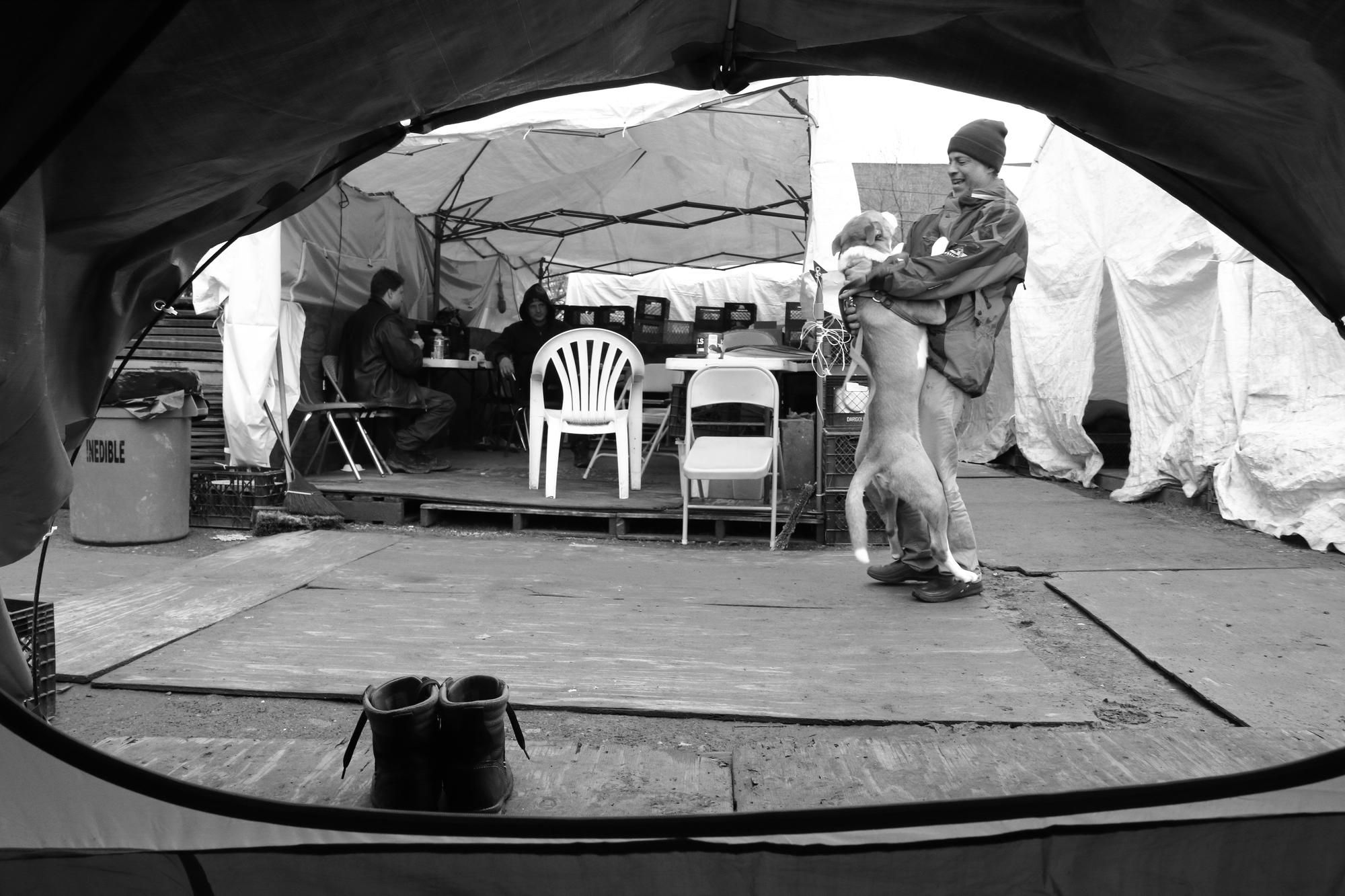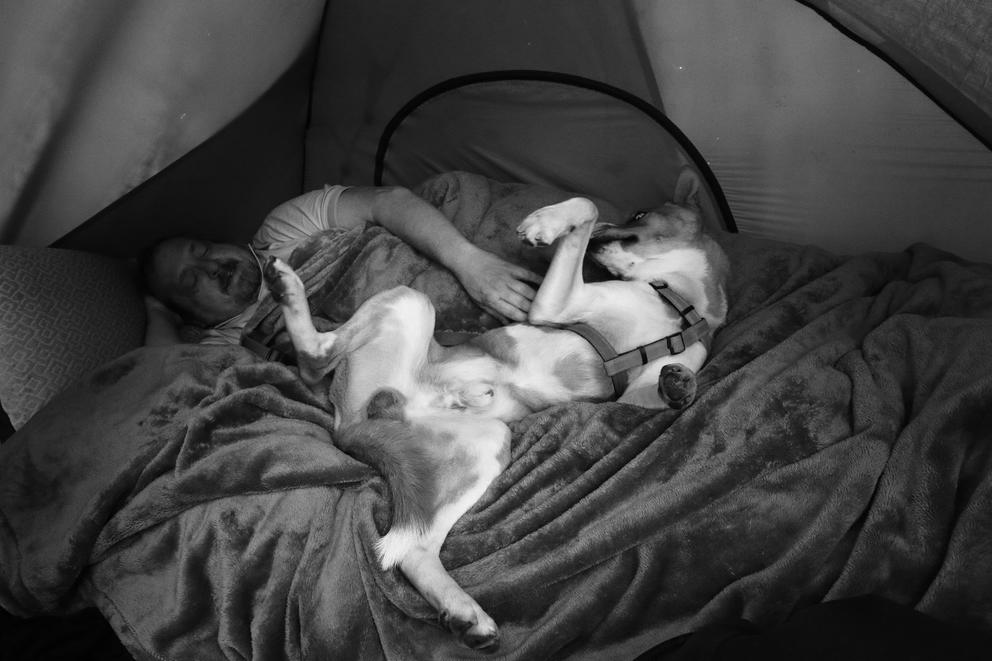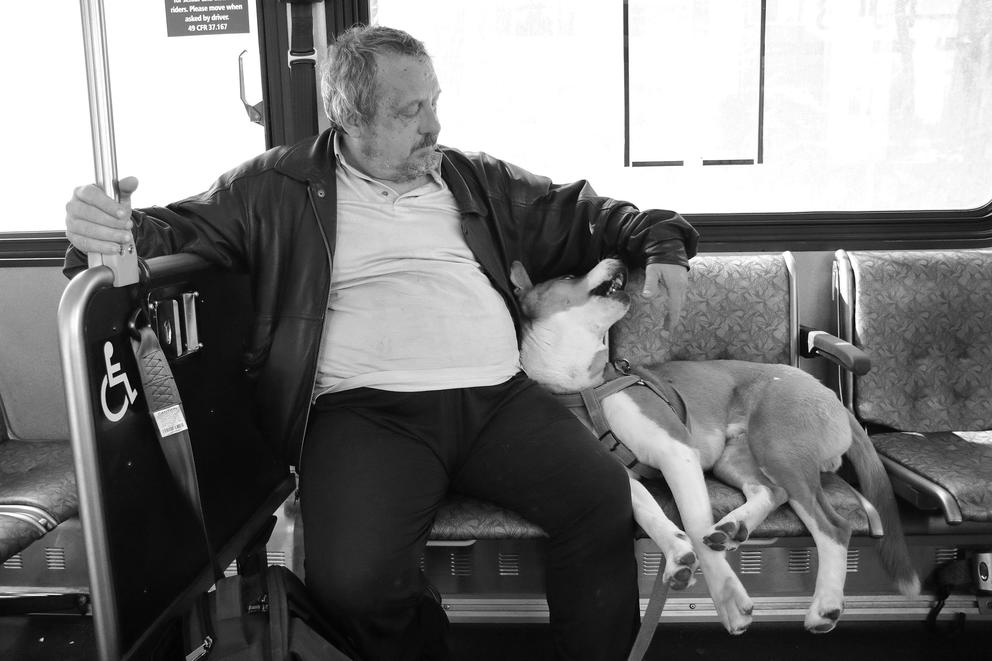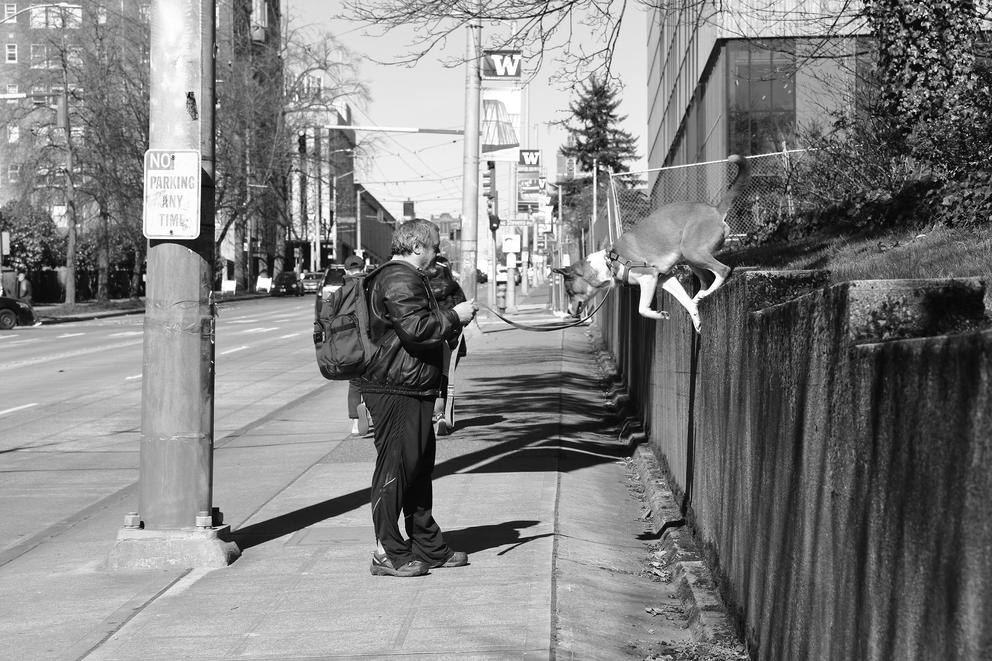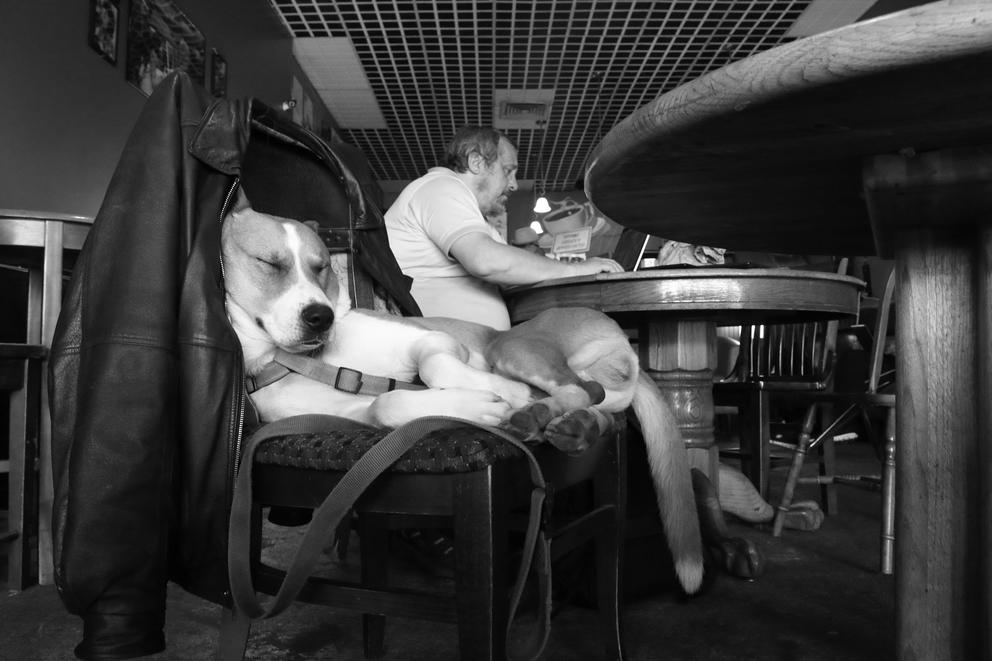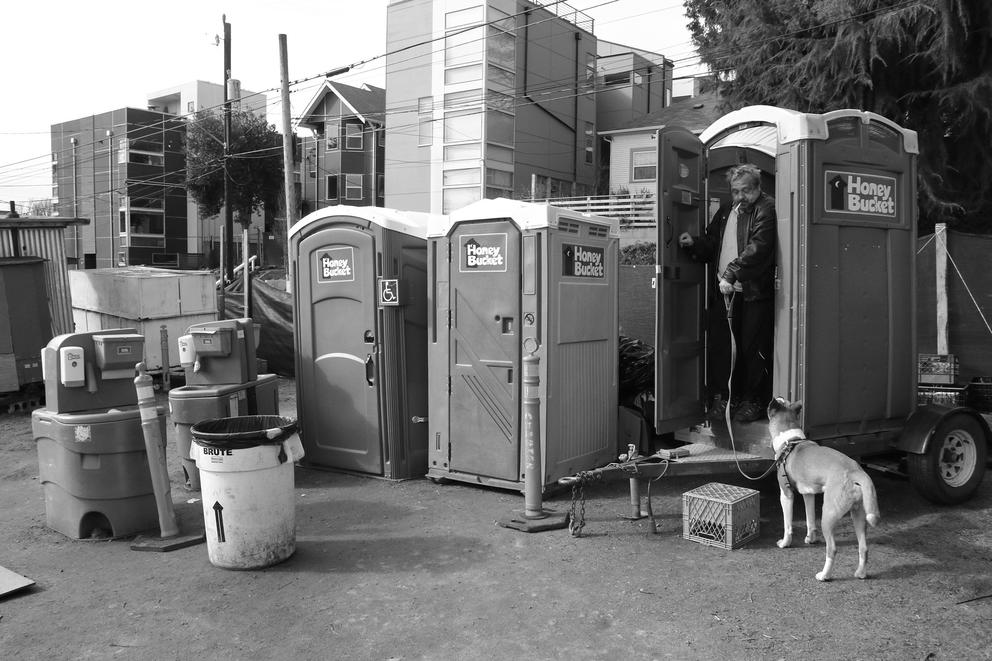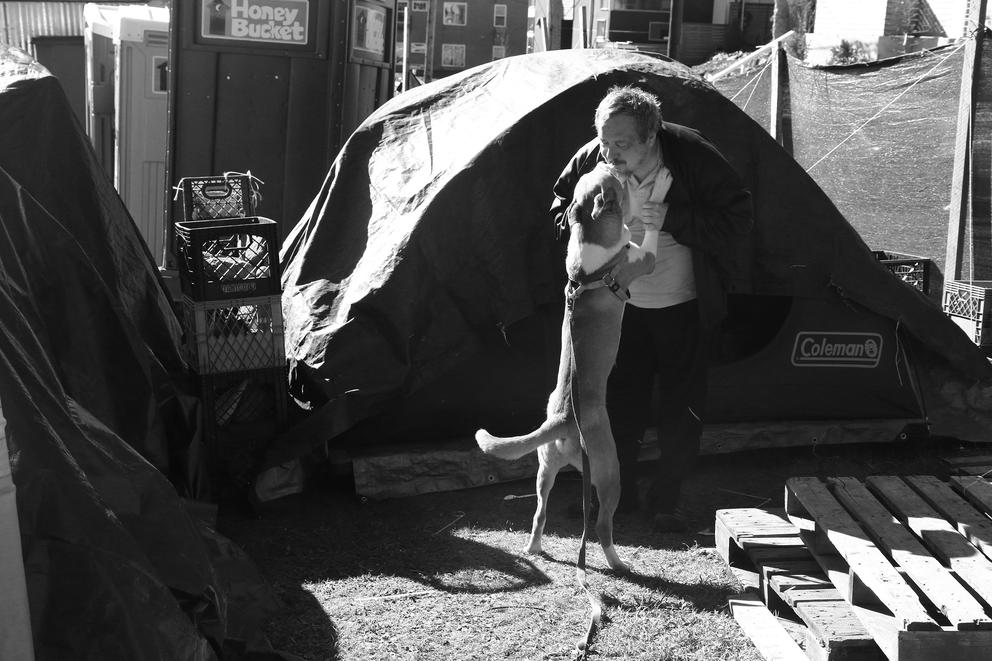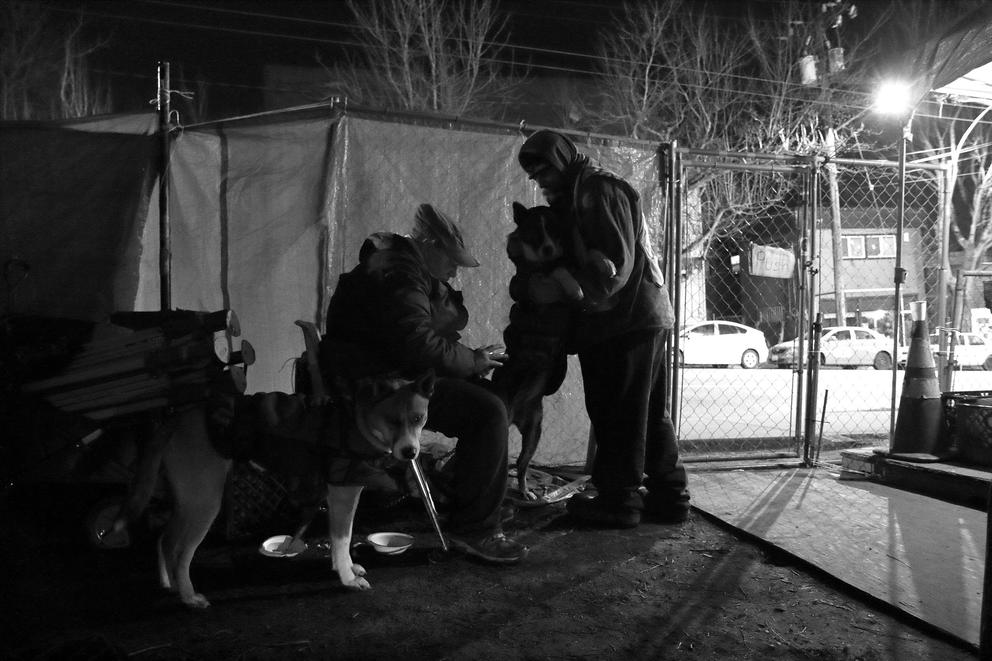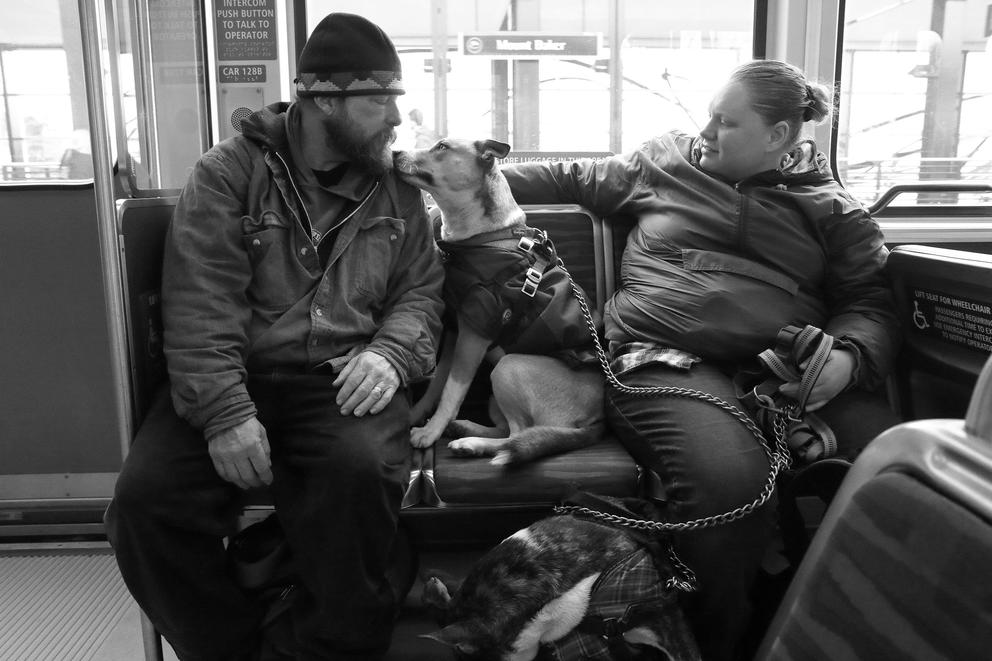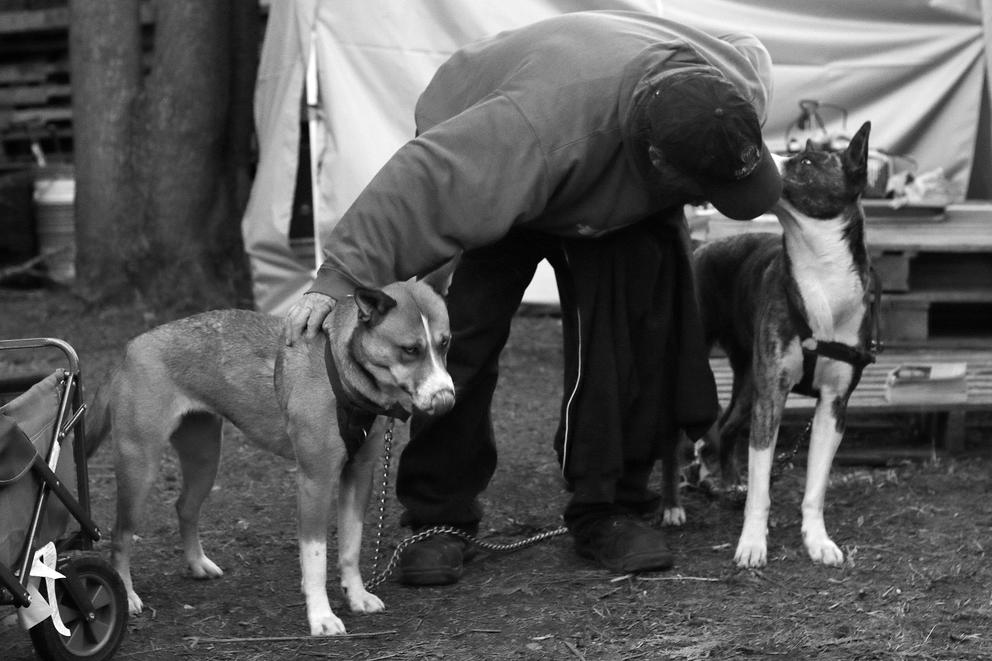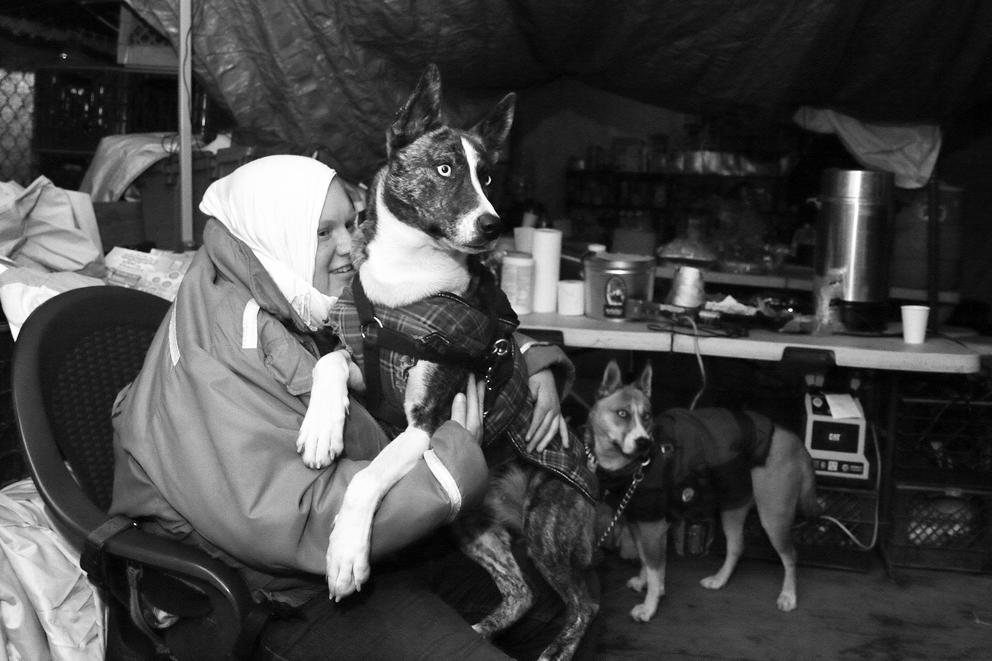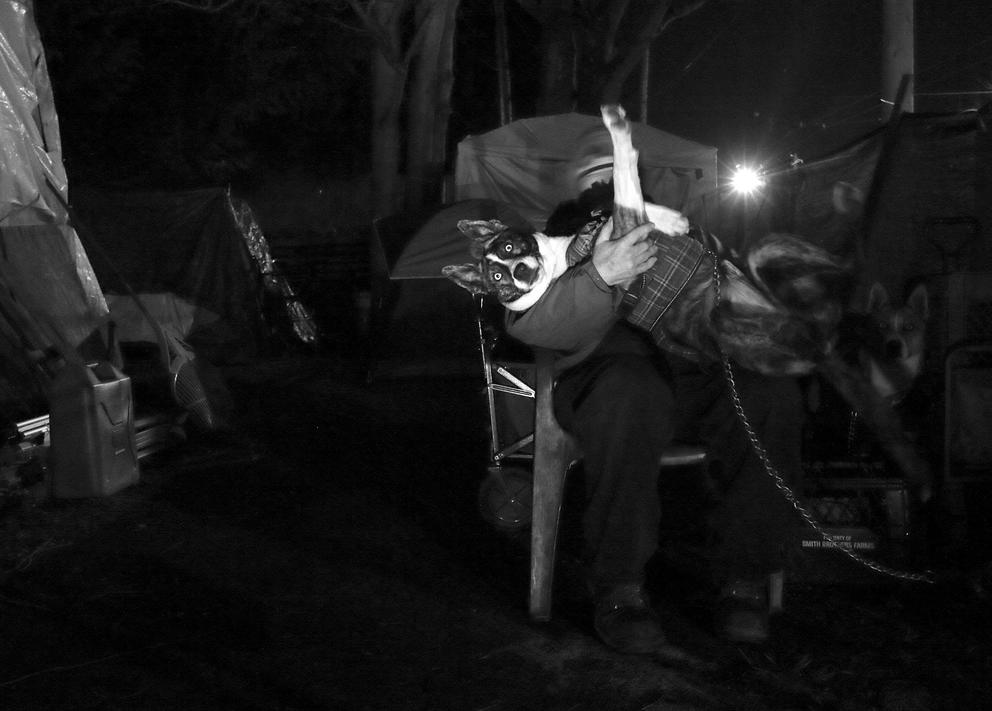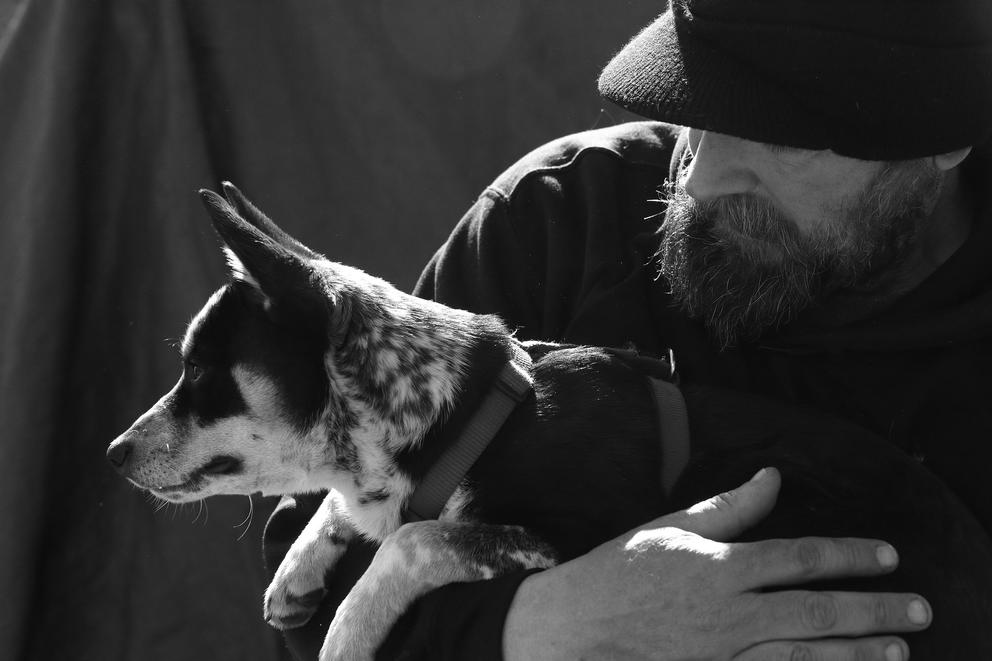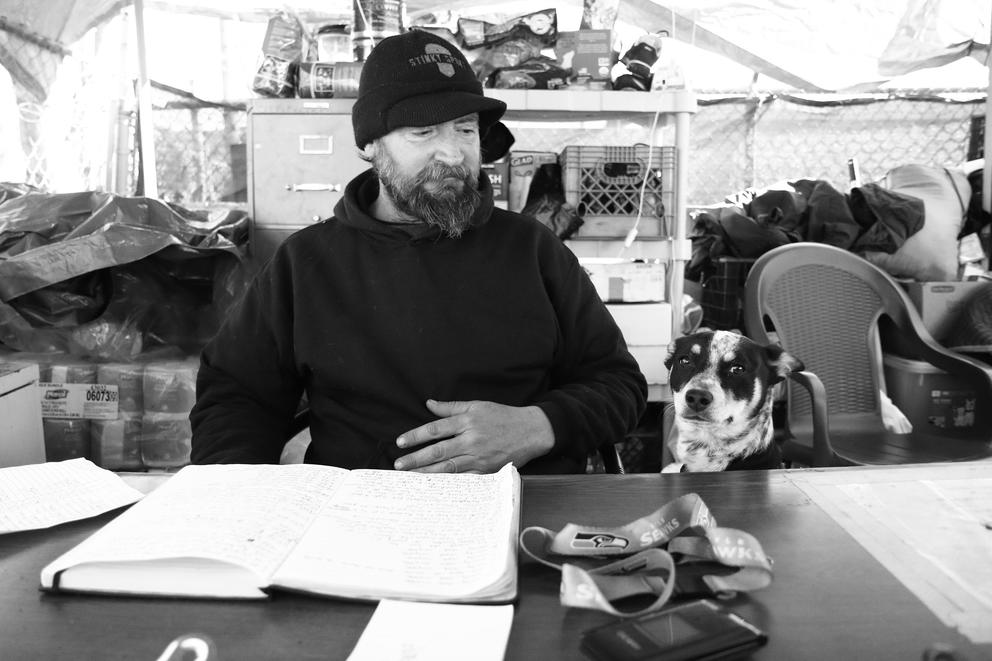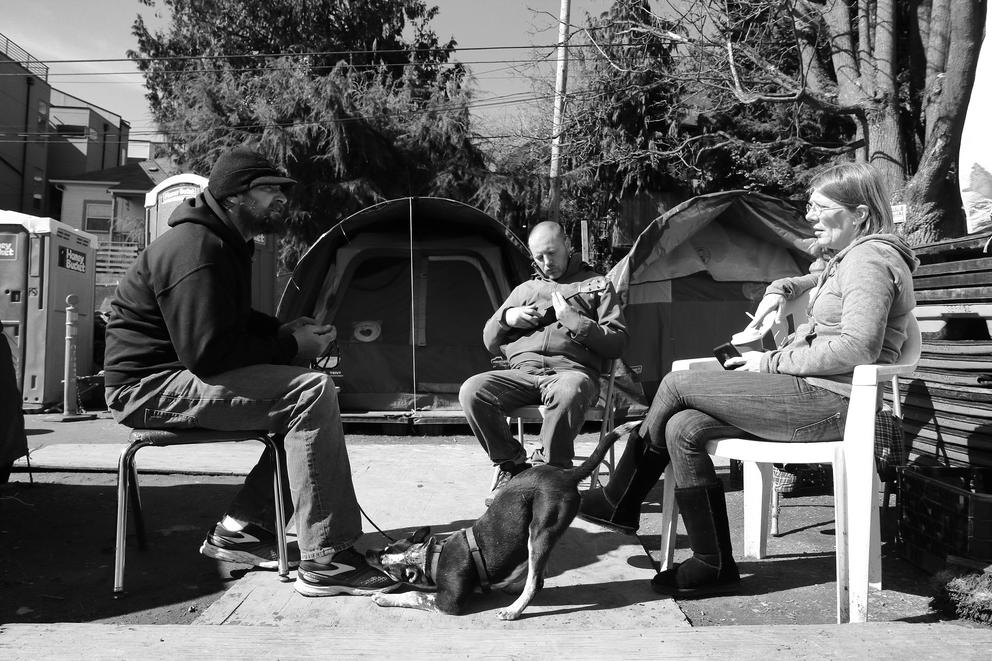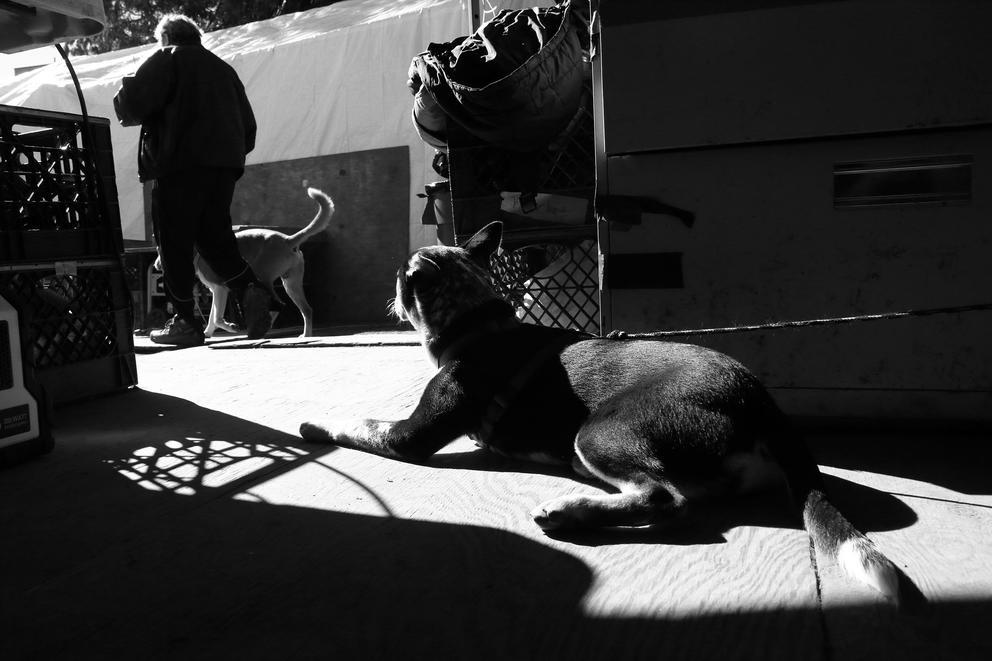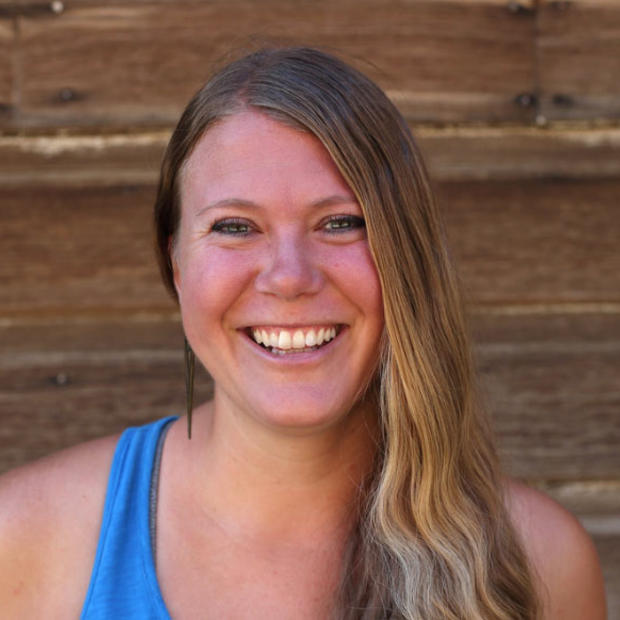I arrived at the encampment hoping to go a little deeper. So I dropped my things and worked with Richard, the camper on the morning’s security shift. We set up my tent, nailing it into a wooden platform and secured a tarp over it for extra measure.
Though I’ve had a brief experience with homelessness as a child, I have never lived unsheltered. I have, however, witnessed firsthand the powerful force that having an animal can be in times of emotional and physical hardship. In 2013, just months into a new research position at the Center for One Health Research at the University of Washington — a group that focuses on the interface of human, animal, and environmental health — the relationship between people experiencing homelessness and their animals emerged as an area of interest.
For five years I have delved into the topic from many perspectives: research, community engagement, outreach, and visual storytelling. By the time I entered TC3, I had already photographed and interviewed about a dozen people living with pets.
I’d heard remarkable stories in which people described their pet as their closest and most loyal friend, a non-judgmental listener, a source of protection, and a companion that provided a sense of responsibility and accountability. I’d also been made aware of the significant hurdles that having a pet can create while attempting to access housing and other services.
Living in an encampment was a chance to take a much more immersive and intimate look at these relationships in the day-to-day, and I spent my time getting to know four of the camp’s pet owners: Sonny, Kevin and couple Ashley and Robert. Being present as they went about their lives with their dogs both inside and outside of camp helped bring the stories I’d been told to life, benefits and barriers included.
Sonny has owned Houdini for just over a year, but he noticed changes as soon as the pup entered his life. In order to be around to care for Houdini as long as he can, Sonny has started taking better care of his own health. He says he was struck by the importance of having something to care for, something that makes him want to get out of bed in the morning.
Sonny was the first to connect with me. Gregarious and happy in front of a camera, he shared the story of meeting his dog, Houdini, who had been in his life for just over a year. Sonny’s struggle with homelessness started decades ago at the age of 18, following the end of a brief marriage. In and out of housing for most of his life, Sonny wondered if getting a dog sooner in life might have led him down a different path.
“He changed my life,” said Sonny. “I’m taking better care of myself because I don’t want to be without him and I don’t want him to be without me.”
Sonny says that Houdini’s support was essential as he connected with a regular doctor and psychiatrist, and signed up for Medicaid. Those close to Sonny noticed the difference it made in his life, too, he said — including his physician, who offered to write Sonny a letter certifying Houdini as an emotional support animal (ESA).
A couple of days later, Ashley and Robert allowed me to tag along with them and their two dogs, Coral and Opal. Sisters of Houdini, Coral and Opal had been with Ashley and Robert just over a year as well. As we rode a series of buses and trains down to the Burien library, a favorite safe space for the four of them, Ashley and Robert told me about the dogs’ role in their life, simultaneously describing their pets as “the ultimate safety net.”
Visits to libraries are an important part of Ashley and Robert's daily schedule. Dogs are allowed in these spaces as long as they're well-behaved, and the couple has trained Coral and Opal to be quiet and rest while they are working on the computers, though they do sneak them little pets here and there.
With temperatures hovering above freezing, Coral helps keep Ashley warm during their nighttime security shifts. The couple likes to sign up for their shifts, required of all TC3 residents, during the night so that they can keep their days open for taking care of other business - like laundry, showering, mail pick up, and checking in at the library.
Coral and Robert share a silly moment while he takes a break from reading his book on the security shift. “You don’t know how much homelessness sucks," says Robert, "I mean, life sucks, but homelessness sucks even more because it’s miserable, dank, dark, and dirty. But when you have two puppies, [it’s not] miserable, dank, dark, and dirty – it’s just two kissy faces who want to go out in the rain.”
Ashley recalled her history of struggling through massive anger outbursts, suicide attempts, and arrests. After just six months of caretaking for Coral and Opal she says she was able to stop taking her medications. She says that her outbursts stopped, allowing for a more stable life, and that she has become more comfortable communicating with others. For Robert, her husband, having the dogs has quelled his interest in drinking.
“Without them he’d have been all over the place trying to look for a beer,” explained Ashley, “while I on the other hand would have beat him senseless.”
They feel this has all changed for them now, though. “There’s no more scenes,” said Robert, “no more explosions. I’m not doing the stupid stuff I was doing because we have the girls now. You spend all day long taking care of your dog. I feel that a lot of your health is how you take care of your dog.”
It wasn’t until the end of my stay that I finally met Go Away, a puppy who spends her time between TC3, where she lives with resident Kevin, and another camp where she stays with Kevin’s ex-girlfriend. After six months with Go Away, Kevin was still coming to terms with both the benefits and barriers her presence has created. Kevin described Go Away as a friend — calling attention to her companionship and her help with his depression, stress and anger.
Kevin and Go Away are in the early stages of their time together, and a favorite outlet for Kevin is playing ball with her on the tennis courts. “It gives me a break from the daily drama,” he explains, “it helps me relieve the stress to just get out and away from it. Work off my aggressions by throwing the ball as hard as I can.” Afterwards, he feels relieved, he says: “Almost as good as taking a hot shower . . . almost."
He says he’s noticed, though, that he is no longer welcome in some of the places he used to go — from grocery stores to community centers. “That business just lost my business,” he said of the places that have asked him to leave. Kevin recognized that certifying Go Away as a service animal or ESA might change these access issues. But with his distrust of the medical profession and no physician, he felt he didn’t have many options to do anything about it.
When my eight days came to a close, I was struck by a multitude of thoughts about my project and what I most want to communicate through it. Living alongside people in camp and seeing their relationships with their pets firsthand was powerful. It helped me to see the delights and the struggles I observed in a more-nuanced light, as simply being the realities of living with an animal.
Whether it be joyful reunions throughout the day, the annoyance of constantly being bit by sharp puppy teeth, or even wanting to register your pet online as a service animal to keep it near, these are things that we experience just by being human, regardless of our housing status. At the core, what I want to communicate through this project is that whether or not you are sheltered is not the defining characteristic of your relationship with your pet. This is the kind of common ground that we need, a way to recognize our shared humanity through our love of an animal.
"Everything to Me" is a documentary photography project partnered alongside community outreach and efforts to increase clinical care for both people and their pets experiencing homelessness in Seattle. It is based upon the premise that a deeper understanding of the bond that people share with their animals can help lead to better options for them to seek and receive care for themselves and their pets, and that housing status alone is not an indicator for a person's ability to care for an animal. For more, visit www.everythingtome.org.

